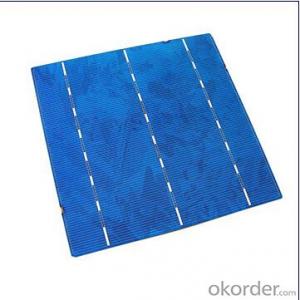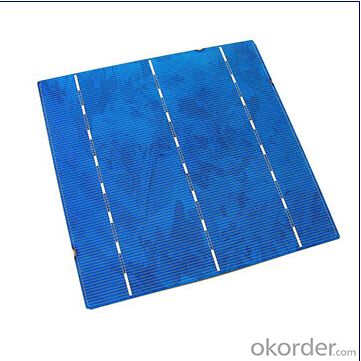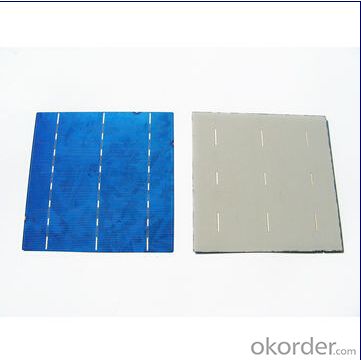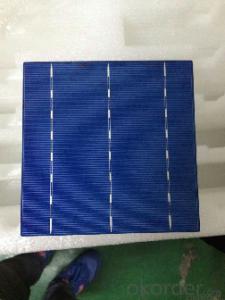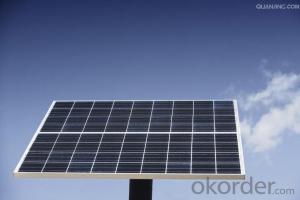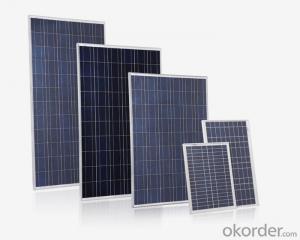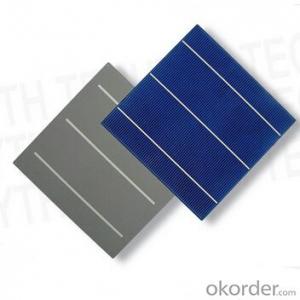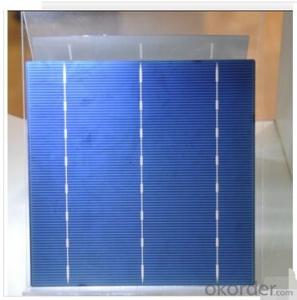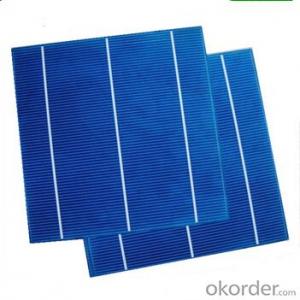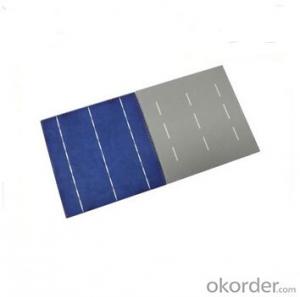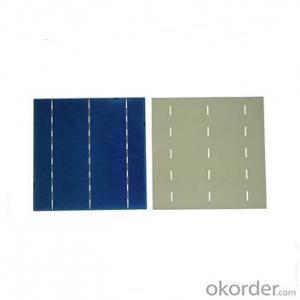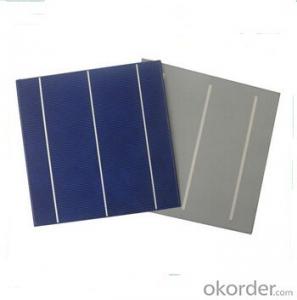Buy Solar Cells in Bulk - Polycrystalline Solar Cells Series C 16.80%
- Loading Port:
- Shanghai
- Payment Terms:
- TT OR LC
- Min Order Qty:
- 3000 pc
- Supply Capability:
- 300000 pc/month
OKorder Service Pledge
OKorder Financial Service
You Might Also Like
Solar Cells:
Solar cells is made by solar wafer, it has three categories of solar cell right now, monocrystalline polycrystalline and thin film,These cells are entirely based around the concept PN junction, which is the critical part of solar module, it is the part that can convert the light energy into electricity, the thickness is from 180um to 200um, with even busbars to conduct electricity, textured cell can decrease diffuse reflection; they are often electrically connected and encapsulated as a module. Photovoltaic modules often have a sheet of glass on the front (sun up) side, allowing light to pass while protecting semiconductor wafers from abrasion and impact due to wind-driven debris, rain, hail, etc. Solar cells are also usually connected in series in modules, creating an additive voltage. Connecting cells in parallel will yield a higher current;With high quality and stable quality. Our Cells can greatly improve the performance of Solar Modules.
Features:
1. High conversion efficiencies resulting in superior power output performance.
2. Outstanding power output even in low light or high temperature conditions
3. Optimized design for ease of soldering and lamination
4. Long-term stability, reliability and performance
5. Low breakage rate
6. Color uniformity
Solar Cells Advantage:
1. Tire-1 Solar Cells’ Manufacturer Quality Guarantee. With a complete and sophisticated quality government system, our Quality Management have arrived world’s leading place. Customer can receive Tire-1 Cells Maker’s Quality Standard Products.
2. Trusted Warranty. We can supply trusted after-sales service to our customer. If our cells are found not in conformity to the specification of manufacturer, or should the inspected quantity found in shortage, or should the packing found damaged, the buyer has the right to claim to the seller. The claim, if any, should be presented to seller within 30 days after cargo's arrival date to the port, together with related inspection report and photos issued and provided by a reputable independent surveyor such as SGS.
3. World’s Leading Manufacturer Equipment. We imported the newest and leading production equipment from abroad. Advanced equipment can guarantee the stable quality of cells. Auto production line can also save labor cost which will further cut our production cost.
4. Bulk supply: With the production capacity of 500MW, we can produce large quantity every month. This can satisfy most customer requirement.
Specifications:
Kit content:
Product: multicrystalline cell based on poly silicone
Format: 156 x 156mm ± 0.5mm
Front contacts (-): 3*1.5mm wide bus bars (silver), acid texturized surface, blue silicone nitride antireflection coating
Back contacts (+): 3*3mm wide bus bars (silver/aluminum), aluminum backside metallization
Warranty:
Repairs: For repairs please contact us
Exchange service: You can choose between a refund, exchange or credit where goods are faulty or doesn’t do what it’s supposed to do
Model | C-16.80% |
Max power | 2W |
Short-circuit current (Isc) | 4.205A |
Imax at 0.5V | 4A |
Open circuit voltage (Voc) | 0.62V |
Size | 156*78mm |
Efficiency | 16.80% |
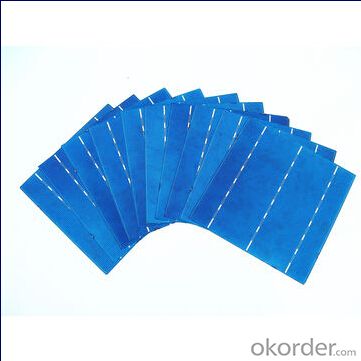
FAQ
We have organized several common questions for our clients,may help you sincerely:
1. What’s price per watt?
A: It’s depends on the quantity, delivery date and payment terms of the order. We can talk further about the detail price issue. Our products is high quality with lower price level.
2. Can you tell me the parameter of your solar cells?
We have different series of cells with different power output, both from c-si to a-si. Please take our specification sheet for your reference.
3.How do you pack your products?
We have rich experience on how to pack the panels to make sure the safety on shipment when it arrives at the destination.
4.Can you do OEM for us?
Yes, we can.
5.How long can we receive the product after purchase?
In the purchase of product within three working days, We will arrange the factory delivery as soon as possible. The perfect time of receiving is related to the state and position of customers. Commonly 7 to 10 working days can be served.
- Q: What is the most common type of solar cell?
- The most common type of solar cell is the crystalline silicon solar cell.
- Q: Can solar cells be installed on sloped surfaces?
- Yes, solar cells can be installed on sloped surfaces. In fact, sloped surfaces can often be advantageous for solar panel installation as they allow for better sun exposure and increased energy generation.
- Q: What is the role of voltage regulators in solar cell systems?
- The role of voltage regulators in solar cell systems is to ensure a stable and regulated output voltage from the solar panels. They act as a control mechanism to prevent overcharging of batteries or damage to electronic devices by regulating the incoming voltage from the solar cells. Voltage regulators also help optimize the efficiency of the solar cell system by matching the voltage levels of the solar panels with the load requirements, thereby maximizing the energy conversion and utilization.
- Q: Can solar cells be used in sports stadiums or arenas?
- Yes, solar cells can certainly be used in sports stadiums or arenas. They can be installed on the rooftops, canopies, or surrounding areas to harness solar energy and generate electricity, thereby reducing the reliance on traditional power sources. This sustainable energy solution can help stadiums and arenas become more environmentally friendly and potentially offset their energy costs.
- Q: What are the different sizes of solar cells?
- Solar cells come in various sizes, ranging from small portable panels for charging devices to large-scale installations used in solar farms. The sizes of solar cells can vary based on the specific application and power output requirements.
- Q: Can solar cells be used on road surfaces?
- Yes, solar cells can be used on road surfaces. Solar roadways are an innovative technology that incorporates solar panels into roadways, turning them into energy-generating surfaces. These solar cells can capture sunlight and convert it into electricity, which can be used to power streetlights, traffic signals, and other infrastructure. However, the practicality and cost-effectiveness of implementing solar roadways on a large scale are still being evaluated.
- Q: Can solar cells be used for powering remote surveillance cameras?
- Yes, solar cells can be used for powering remote surveillance cameras. Solar cells capture sunlight and convert it into electricity, which can then be used to power various devices, including surveillance cameras. This makes solar-powered surveillance cameras a sustainable and cost-effective option for remote locations where access to electrical grids may be limited or non-existent.
- Q: Can solar cells be used for powering agricultural irrigation systems?
- Yes, solar cells can be used for powering agricultural irrigation systems. Solar energy can be harnessed by installing solar panels that convert sunlight into electricity, which can then be used to power pumps and other equipment necessary for irrigation. This renewable energy source offers a sustainable and cost-effective solution for powering agricultural practices, especially in areas with limited access to electricity.
- Q: Can solar cells be used for powering outdoor signage?
- Yes, solar cells can be used for powering outdoor signage. Solar panels can convert sunlight into electricity, which can then be used to power various devices including outdoor signage. This is a sustainable and environmentally friendly option, as it reduces dependence on traditional electricity sources and helps to minimize carbon emissions.
- Q: What is the impact of solar cell installations on greenhouse gas emissions?
- The impact of solar cell installations on greenhouse gas emissions is significant as they provide a clean and renewable source of energy. By harnessing sunlight and converting it into electricity, solar cells reduce reliance on fossil fuels, which are major contributors to greenhouse gas emissions. Solar power generation produces no direct emissions during operation, thus helping to mitigate climate change and reduce overall carbon dioxide and other greenhouse gas emissions.
Send your message to us
Buy Solar Cells in Bulk - Polycrystalline Solar Cells Series C 16.80%
- Loading Port:
- Shanghai
- Payment Terms:
- TT OR LC
- Min Order Qty:
- 3000 pc
- Supply Capability:
- 300000 pc/month
OKorder Service Pledge
OKorder Financial Service
Similar products
Hot products
Hot Searches
Related keywords
